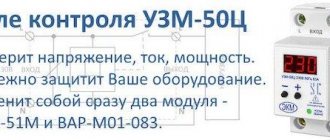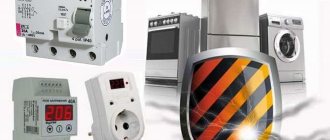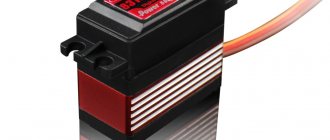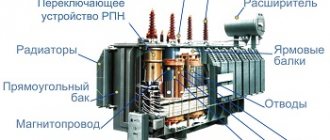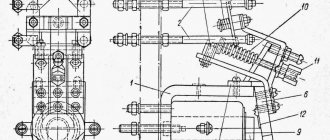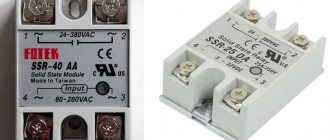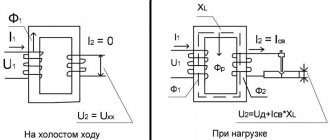What is it for?
A phase and voltage control relay is a device that is necessary when connecting equipment to a system with three phases, as well as in situations where it is important to maintain correct alternation.
In practice, the product is used when equipment is frequently transferred, when changing the phasing may cause damage or incorrect operation.
A striking example is a screw-type compressor, the incorrect connection of which and switching on for more than five seconds leads to breakdown of an expensive product.
The phase and voltage monitoring relay allows you to identify the following problems:
- Break of any phase;
- Increase or decrease in voltage above (below) a given level;
- Phasing violation (phase connection order);
- Break of “zero”;
- Asymmetry of I and U (here we are talking about phase imbalance, when the angle between the vectors is significantly more or less than 120 degrees).
The schematic diagram of the device is shown below.
Some relays provide the ability to change the settings for the upper and lower limits U, as well as T (time) of operation.
As a rule, the output contact group of the relay is “dry”. In this case, there are two options available - normally closed and open. Some models have elements that operate on the induction principle.
Settings
To configure the voltage relay, you need to connect it to the network and apply voltage. Now pay attention to the following.
- If the numbers appear on the display, but it is blinking red, this indicates that the load has not yet been applied.
- If dashes appear on the monitor instead of numbers, then there are two options: either one of the phases is missing, or the phase sequence has changed.
- If everything is normal, that is, there is no phase rotation violation, the input voltage corresponds to the nominal voltage, there is no large phase imbalance, then after fifteen seconds the relay should close contact 1-3, which will power the contactor coil. After which the voltage will begin to flow to the consumer.
- If the device is still blinking, the contactor will not turn on. That is, somewhere you did not meet one of the conditions for correct connection and configuration.
Design and principle of operation
Despite the variety of voltage phase control relays, the design features are almost unchanged. The device is based on microprocessors with an embedded program and the ability to customize. This design ensures reliable operation and low maintenance.
The design of the product also includes a circuit that calculates the order of the arrangement (sequence) of phases, and also monitors the compliance of the current situation with the program that is embedded in the relay.
On the simplest models, three phases and a neutral conductor are connected to the input, and a relay with a changing contact is provided at the output terminals.
Voltage to the internal circuit is usually supplied from the first phase (L1). For clarity, a pair or more indicators are installed (much depends on the product model) and the manufacturer.
More expensive relays have a regulator that allows you to change the setting over time (see photo above). Thanks to this option, you can increase or decrease the relay response time when executing a specific program.
In addition, many devices have a circuit that responds to a decrease or increase in voltage.
The operation of the U phase control relay is based on the separation of negative sequence harmonics (from 2 and above). In this case, only harmonics that are multiples of “two” are used, that is, “fourth”, “sixth”, “eighth” and other harmonic components. They appear in the event of a break in any of the supply phases.
To isolate such U, special filters (also negative sequence) are used, the role of which is played by analog-type filters. They include active and reactive units (resistors and capacitors, respectively).
Features of common types of voltage relays
Thanks to the voltage relay, during power surges the device will not burn out, the board will not melt, or the electric motor will not fail. The cost of the devices is considerable, but they pay for themselves. It is better to prevent accidents than to buy new equipment.
There are several types of control relays on the market from different manufacturers. They have the same principle of operation, although the design and set of additional functions may differ.
Modern devices have a digital display. It allows you to monitor the voltage level in three phases. There are also additional settings. With their help, they regulate the operation of the device and ensure simplicity and ease of use.
A three-phase voltage control relay is an indispensable thing in the household. It is not difficult to connect and configure. This will take no more than half an hour, after which all electrical appliances will be protected from voltage surges.
Source
Types
The most popular types of relays designed for phase control include EL models of the following series - 11, 12, 13, 11MT and 12MT.
It is important to take into account that the scope of application of the product depends on their types of voltage phase control relays (EL):
- 11 and 11 MT - protection of power supplies, participation in the automatic transfer system, power supply of converters and generator sets.
- 12 and 12MT - to protect cranes with a power not exceeding 100 kW.
- 13 - used when connecting electric motors of a reversible type with a power of up to 75 kW.
The devices are fixed on a special DIN rail or only with screws (depending on the situation).
Characteristics
Modern phase control relays are selected taking into account the following characteristics:
- VOLTAGE. Operating U directly depends on the equipment specification. For example, EL Series 11 can operate at voltages from 100 to 415 V (including 110 V, 220 V, 380 V and 400 V). As for EL 13, they operate on voltages of 220 and 380 V.
- OPERATION LIMIT. This parameter also depends on the type of relay and the current situation. Thus, with a symmetrical decrease in voltage, EL series 11, 12 and 13 devices have a minimum limit of 0.7; 0.5 and 0.5 Ufn respectively. In the event of a break in one or more phases, all relays will operate. If the alternation is disrupted, then models EL11 and 12 recognize the problem and close the contact group, but EL13 does not.
- DELAY TIME. This indicator reflects how much the response of the voltage phase control relay is delayed when the required setting is reached (the specified threshold value). For models EL11 and 12 this figure is from 0.1 to 10 seconds (depending on the adjustment), and for EL13 - up to 0.15 seconds.
- WORKING TEMPERATURE. As in the cases discussed above, the situation here depends on the type of relay. EL types 11 and 12 operate from 40 degrees below zero to 40 degrees above zero. As for EL13, these relays have a smaller range - from -10 to +45 degrees Celsius.
- Storage temperature - from -60 to +50 degrees Celsius.
- Product weight - 300 grams (EL 11 and 13) and 250 grams (EL 12).
Three-phase voltage relay how to set up
The voltage relay is designed to disconnect household loads in the event of unacceptable voltage fluctuations in the network with automatic restart after restoration of network parameters. In normal mode, the voltage relay passes the entire load current through itself, and at the same time serves as a digital indicator of the voltage level and, in some models, the current consumption.
Agree, this is very convenient, therefore it is recommended for installation in every home electrical panel due to the fact that the electrical network supplied to a house or apartment can be unpredictable in its parameters.
A simple example is the shave or burnout of a zero in a floor electrical panel, which will undoubtedly lead to a phase shift where the voltage in the apartment’s sockets will “go wild” and can even reach 400 volts! Naturally, all unprotected electrical appliances that will be connected to the network at this time will fail.
Among other things, for various reasons, pulsed “spikes” of high voltage may appear in the network, or the voltage may “drop” to critically dangerous low voltage levels at which household electrical appliances may also fail.
In all such cases, voltage relays can be used to protect home equipment. But despite its useful properties of passing only the optimal voltage into the sockets, if there are frequent voltage drops in your electrical network, for example in rural areas where the equipment of local power plants is still old, you should pay attention to a voltage stabilizer.
Despite the great abundance of manufacturers producing voltage relays of different models, all models have the same operating principle and often connecting it will not be a problem. You can read about the selection, parameters and correct connection diagrams for voltage relays here.
The electrical connection diagram is both in the instructions and on the device itself.
After installing the voltage relay in the electrical panel, there comes a time when it needs to be properly configured for reliable and safe operation of home electrical equipment, especially refrigerators, air conditioners and other freezing, compressor and other equipment..
Subtleties of choice
When choosing a voltage phase control relay, you need to focus on the technical parameters of the device that is connected to the circuit.
For example, consider a situation when you need to select a model for connecting an ATS.
The algorithm of actions is as follows:
- WE DETERMINE THE CONNECTION METHOD - with or without “zero”.
- WE DETERMINE THE PARAMETERS. For an ATS circuit, it is important that the device monitors the fact of phase failure and the phase sequence. In this case, the delay time should be in the range between 10 and 15 seconds. Control of oscillations U greater or less than the set point is required. To switch a relay with the 0th wire, visual inspection is required for each phase.
After analyzing the requirements considered, preference can be given to EL11E.
In addition, when choosing, you need to take into account the modification of the relay. For example, domestically produced devices are designated as EL.
As for foreign products, their markings are somewhat different. For example, RANA B380 A A 3 C. Here “RANA” is the name of the series, B380 is the voltage 380V. The next two letters A are regulation using a potentiometer and the type of installation (for DIN rail). The number “3” indicates the case size of 3.5 cm, and C is the last digit of the marking.
Phase control relay EL-11E (380 V, 50 Hz), RKF, IEK
These phase control relay models are produced by, which has been on the market since 1992. The company is located in St. Petersburg.
The company's activities are based on the development and manufacture of industrial automation devices. During its existence, the company has managed to take a leading position in the manufacture of electronic devices on the Russian market. The number of goods produced exceeds 500 units.
The company's clients include such giants as Gazprom, Russian Railways, Aurora Concern, Lenenergo and others. The company's products are in high demand due to their quality and wide range of models.
Customers have at their disposal electronic time relays, voltage monitoring devices, maximum current relays, lighting control devices and much more.
Description and technical characteristics of relay EL-11E (380 Volt, 50 Hz)
The EL-11E relay has one normally closed, normally open and changeover contact.
The device is designed to control phases in a 3-phase network, operating at an alternating voltage of 380 Volts. In practice, it is used to control the presence of U and correct symmetry.
Connecting a voltage monitoring relay in a single-phase, two-phase, three-phase network
Quite often there are situations when, due to a sharp voltage drop, all household appliances in the house fail.
Such troubles are especially typical for old houses with obsolete electrical wiring.
To protect electrical appliances from premature failure, it is recommended to install a voltage relay. article ⇒ Voltage relay - how to connect.
Application area
A voltage relay is a device whose job is to control the voltage in the network in which it is installed, as well as rectify it to the specified parameters when it decreases or increases.
AC voltage tends to make surges, which negatively affect the operation of household electrical appliances and can damage them. It is for this purpose that a voltage control relay is installed. This device is used in domestic and industrial conditions for stable operation and protection of electrical appliances from power surges.
Relay RN-113 is used to disconnect industrial and household single-phase loads
Types and classification
Devices such as voltage monitoring relays are designed to:
- connecting a single device;
- connecting multiple devices;
- voltage control throughout the network.
Voltage relays for one device look like a plug with a socket. Can only be used for one device. Multi-appliance voltage relays look like an electrical plug with multiple outlets. Used for several low-power electrical energy consumers.
- article ⇒ How does a voltage control relay work?
- The voltage control relay for the entire network is installed in the panel where the meter and circuit breakers are located.
- Such devices are also divided into:
ZUBR voltage monitoring relays reliably protect three-phase networks from overvoltages
Single-phase voltage relays are used in household networks. Three-phase voltage relays are used in industrial installations.
Advantages and disadvantages of the device
The advantages of this equipment are:
- the ability to control voltage in this network;
- stability and trouble-free operation in the temperature range from -20 to +40°C, which allows the use of such a device in almost any conditions;
- significant differences in dimensions compared to voltage stabilizers;
- modern look and DIN rail mounting;
- work in automatic mode.
Among the negative qualities, the following nuances can be noted:
- for maximum efficient operation it is necessary to install several voltage control relays;
- When this device is connected to the entire network, if there are significant voltage fluctuations, the entire network is de-energized for some time.
Operating principle of voltage control relay
Since the main task of this device is to control voltage, the device has two components in its body: electronic and power parts.
The electronic part monitors the network voltage, and if it goes beyond the established permissible limits, it sends a signal to the power part to turn off the network. That is, the electronic part serves only for control, and the power part performs a shutdown.
Tip No. 1: The device’s response thresholds can either be set individually or be already preset by the manufacturer.
Phase control relay Schneider
The Schneider company is considered one of the best manufacturers of devices in the electrical power industry. The products of this company are actively used both at civilian sites and in large industrial organizations.
The advantages of the company's products include a flexible pricing policy, high quality and special conditions for customers.
The company produces circuit breakers, fuses, load switches and switchboard equipment.
In addition, the Schneider plant produces relays, switches, sockets, contactors and many other devices.
Popular models include relays:
- Control of 1-phase voltage (from 65 to 260 V and time delay from 0.1 to 10 s - RM17UBE
- 3-phase voltage control (208 to 480 V) - RM17TE
- 1-phase voltage control (160 to 280 V, 30 second delay) - EZ9C
- 3-phase voltage control (from 208 to 480 V) - RM17TT00 and others.
Three phase voltage relay
The task of circuit breakers is to protect against overloads and short circuits, and the RCDs installed with them protect against current leaks. But, these devices are effective only in single-phase networks, but there are also three-phase networks with their own operating characteristics. To prevent possible negative consequences, in such networks a three-phase voltage relay is used, which is triggered when a phase cable or neutral wire breaks, during pulse surges and other faults.
ABB phase monitoring relay
ABB has been operating since 1883, which is further confirmation of the reliability and relevance of the Swiss brand’s products.
Initially, the manufacturer produced generators and lighting devices, but in 1891 the production of electrical machines began.
At the present stage, the manufacturer’s offices operate in numerous countries around the world, and their number has exceeded 100.
The company produces and markets products for automation of production, generation and transmission of electricity, protection and automation of various facilities in the energy sector.
The most popular models include the following voltage control relays - CM-PVE, CM-MPS.21S, CM-MPS.41S, CM-PFS and others.
They all differ in voltage level, type of fastening, holding time and other parameters.
Varieties
There are several form factors of voltage monitoring relays:
- Plug-socket. The simplest type of device. On the one hand, it has a regular plug that fits into any European socket. On the other hand, there is the same socket for connecting any device. There are also adjustment levers and a display.
- Extension. Its device is similar to the previous one, only it is additionally equipped with a wire of the required length and several sockets for plugs.
- With installation on DIN rail. The most common type of device. They are installed in a distribution cabinet, on a special mounting plate. The advantage of such models is the ability to protect the entire room, as well as a large selection of adjustments.
As you can see, the optimal solution is installation on a DIN rail in the distribution panel. And portable devices are suitable when temporary protection of electrical appliances is needed in areas with unstable voltage.
How to connect the device? Scheme
Let us immediately note that if a frequency converter is used in the equipment connection circuit, the installation of a voltage control relay is not required.
When connecting the product, it is important to follow the instructions supplied by the manufacturer. In most cases, the diagram is indicated directly on the product body, which simplifies installation and connection.
Connection to the product contacts at the input and output is carried out using wires, and they are secured using special clamps.
Wires of 2.5 “squares” or double wires of 1.5 “squares” are used as a conductor. When connecting, it is important to observe the correct rotation of the three phases.
The connection diagram can be different, both with and without a “zero” wire. The first option is usually found in private houses and apartments. In this case, the load is evenly connected to each phase. If there is a deviation from the norm, the relay is activated.
Diagram and video of connection EL-11M-15
RCD connection diagram
In apartments, connecting a three-phase network is rare. This option is popular for private homes. The protection device is connected in several ways:
- A 380 V 2-pole voltage relay is not suitable for home use. Use 4-pole analogues. 1 neutral conductor and 3 phase conductors are connected to them. The circuit is complicated by the fact that each line is equipped with its own RCD device. It is important to choose the right wires. For a single-phase network, the standard VVG version is suitable, but for a 3-phase network you need a fire-resistant VVGng.
- General RCD for 3-phase network + meter. The circuit contains an electricity meter. Group RCDs are located in the system for servicing individual lines. This scheme requires the installation of a large electrical panel with many wires and electrical appliances.
If an apartment or house has a large number of lighting and socket circuits, as well as a variety of household appliances, it is advisable to install double protection with a common RCD.

